Strategic portfolio management is heralded as the future of business continuity planning. It involves aligning strategic initiatives with organizational objectives, resources, and capabilities to maximize value delivery.
This is achieved by continuously assessing, balancing, and optimizing portfolios of initiatives to ensure resources are allocated according to their potential for maximizing return on investment.
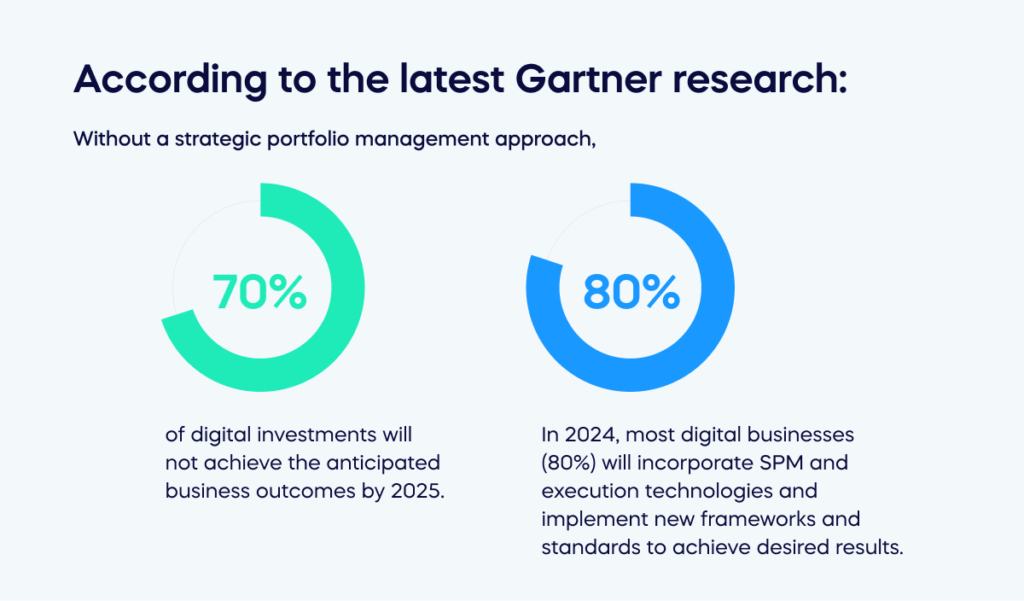
According to the latest Gartner research:
- Without a strategic portfolio management approach, 70% of digital investments will not achieve the anticipated business outcomes by 2025.
- In 2024, most digital businesses (80%) will incorporate SPM and execution technologies and implement new frameworks and standards to achieve desired results.
Strategic portfolio management requires understanding the organization’s strategy, value drivers, and change initiatives. It also involves understanding industry trends and competitive pressures.
Strategic portfolio management (SPM) provides valuable insights that simplify decision-making and execution. Those with a broad organizational perspective understand that balancing competing needs is challenging, but it keeps overarching objectives focused and plans efficiently executed.
Strategic portfolio management is the solution for this challenge. It allows organizations to identify their most valuable initiatives and determine the best path for achieving desired outcomes. This approach incorporates techniques like portfolio analysis, value-based decision-making, integrated risk management, and scenario planning.
Ultimately, strategic portfolio management enables organizations to align resources and capabilities effectively to maximize value delivery and enhance overall performance. By leveraging this approach, organizations can make informed decisions to improve outcomes.
This article provides a comprehensive overview of strategic portfolio management, its key elements, and how it can be leveraged to improve organizational performance.
What is strategic portfolio management?
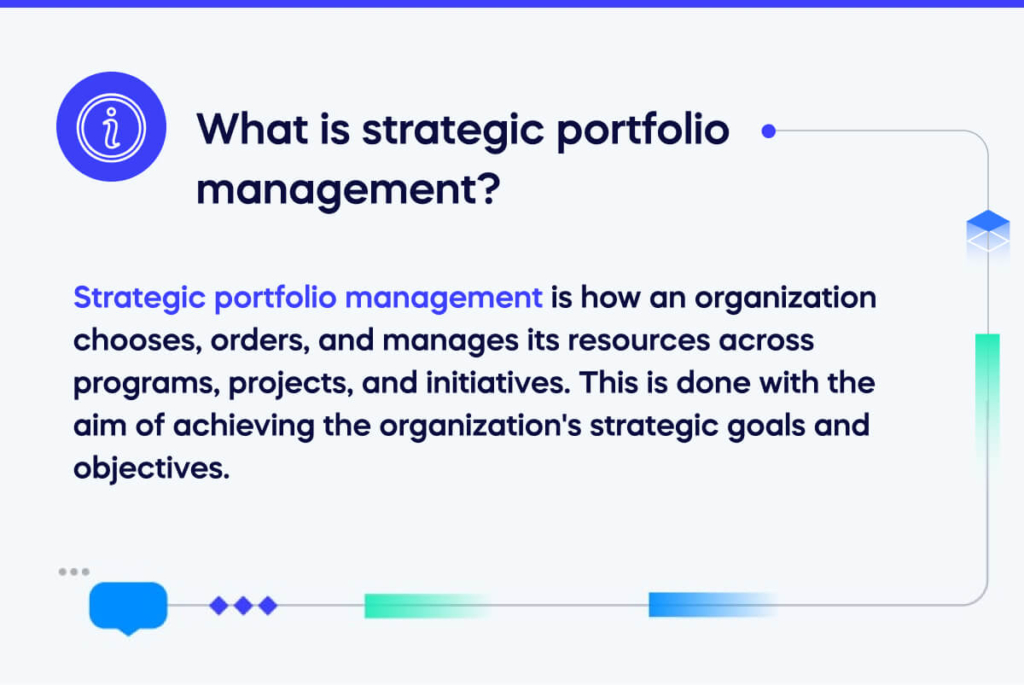
Strategic portfolio management is how an organization selects, orders, and manages its resources across programs, projects, and initiatives to achieve strategic goals and objectives.
In today’s dynamic business landscape, success depends on an organization’s ability to navigate changing goals and objectives. Balancing change implementation, maintaining current initiatives, and maximizing ROI is a significant challenge.
Strategic portfolio management offers a framework for businesses to optimize investments and improve processes. By leveraging this approach, companies can stay ahead, surpass the competition, and ensure long-term growth.
Thus, implementing a portfolio management strategy is no longer a luxury but a necessity for companies aiming to thrive in a rapidly evolving business environment.
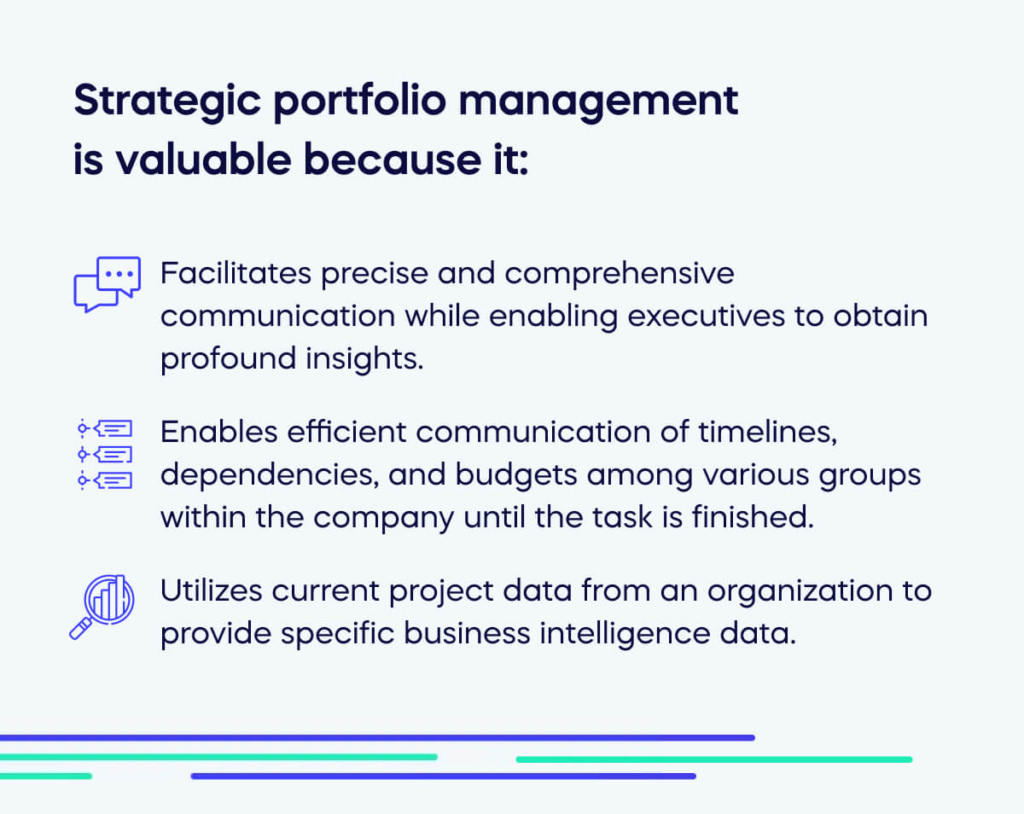
Strategic portfolio management is valuable because it:
- Facilitates precise and comprehensive communication while enabling executives to gain profound insights.
- Enables efficient communication of timelines, dependencies, and budgets among various groups within the company until tasks are completed.
- Utilizes current project data from an organization to provide specific business intelligence.
Still wondering what strategic portfolio management is? Here are the main ways companies benefit from it.
Strategic portfolio management benefits
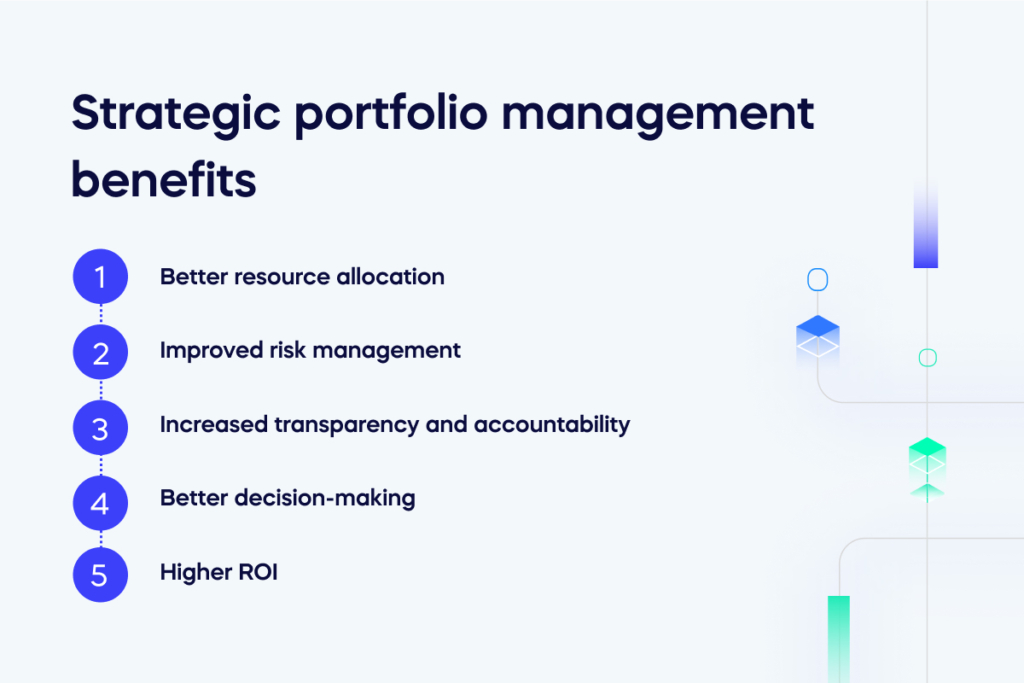
In today’s dynamic business landscape, continuously adapting and optimizing investments is crucial for staying ahead of the competition.
Strategic portfolio management equips companies with tools and insights to prioritize tasks effectively and achieve strategic goals. By employing Agile and intelligent systems capable of real-time response, organizations can unlock benefits that guide their initiatives.
These include:
- Better resource allocation: A significant benefit of strategic portfolio management is optimizing resource allocation. By implementing a strategic portfolio management system, organizations can prioritize and allocate resources to projects with the highest potential ROI. This ensures resources are used efficiently and contribute to the company’s strategic objectives. For example, by focusing resources on projects aligned with long-term goals, organizations avoid wasting resources on initiatives not aligned with their strategy.
- Improved risk management: Strategic portfolio management helps organizations assess and manage risk at a portfolio level rather than project-by-project. This approach enables organizations to identify potential risks and mitigate them, reducing the impact on individual projects and the portfolio. For example, by implementing a risk management framework, organizations can identify and prioritize risks, develop mitigation strategies, and monitor risk throughout the portfolio.
- Increased transparency and accountability: Strategic portfolio management provides a clear view of all projects and their progress, allowing stakeholders to track performance against strategic goals and hold teams accountable for results. This transparency fosters a culture of accountability and ensures all projects align with strategic objectives. By providing visibility into project progress, decision-makers can make data-driven decisions that positively impact the organization.
- Better decision-making: By providing real-time data and insights, strategic portfolio management enables informed decisions about resource allocation and strategy adjustments to optimize portfolios. This is crucial as business landscapes constantly evolve, requiring organizations to adapt to stay competitive. With real-time data, decision-makers are better equipped to make the right choices and pivot quickly when necessary.
- Higher ROI: Perhaps the most significant benefit of strategic portfolio management is improving overall ROI by selecting and prioritizing projects that align with strategic objectives and have the highest potential impact. This results in more efficient resource use and greater returns. For example, by conducting a portfolio analysis and prioritizing high-potential initiatives, organizations can focus on projects likely to have the greatest impact, resulting in a higher ROI.
Strategic Portfolio Management Use Cases
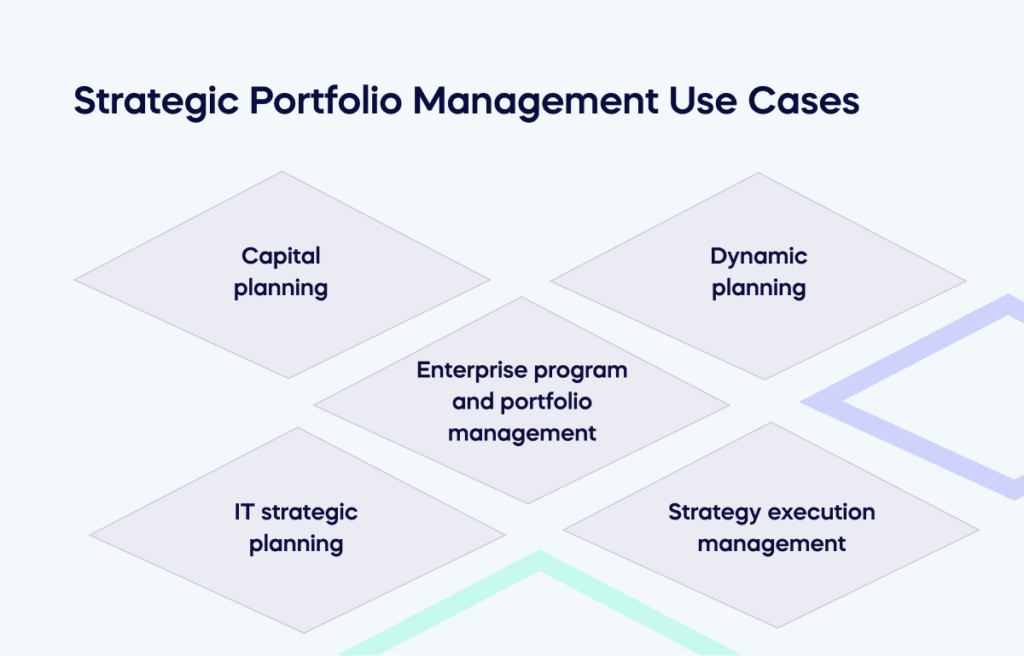
Learn how organizations utilize strategic portfolio management to lead transformational change, monitor performance, and measure progress for faster strategy delivery with a well-defined plan.
Capital planning:
Capital planning involves identifying, evaluating, and selecting capital investments to support strategic objectives. It includes analyzing costs and benefits, assessing risk, and selecting projects that align with long-term goals.
Capital planning is typically done at an enterprise level and involves cross-functional collaboration and input from key stakeholders to ensure alignment with the company’s overall strategy.
Dynamic planning:
Dynamic planning is an iterative process of continuously evaluating and adjusting plans in response to changing business needs. It involves developing a flexible planning framework that enables quick reactions to market changes, customer needs, and other impacting factors.
Dynamic planning relies on real-time data and analytics to inform decision-making and prioritize initiatives, ensuring efficient and effective resource allocation.
Enterprise program and portfolio management:
Enterprise program and portfolio management (EPPM) is a process for managing multiple portfolios and programs across an organization. It involves establishing a governance framework that aligns projects with strategic goals, defines key performance metrics, and ensures effective resource use.
EPPM enables organizations to optimize resource allocation and achieve greater efficiency by prioritizing key initiatives, managing risk, and ensuring visibility of program and portfolio performance.
IT strategic planning:
IT strategic planning involves developing a plan for IT investments and initiatives that aligns with overall strategic goals. It includes identifying IT capabilities required to support business objectives, evaluating costs and benefits, and prioritizing initiatives based on business value.
IT strategic planning is essential to ensure IT investments and resources align with company goals and deliver optimal value to the enterprise.
Strategy execution management:
Strategy execution management involves managing the execution of initiatives across the organization, ensuring they are executed on time, within budget, and deliver desired outcomes. It includes establishing key performance metrics, monitoring progress, identifying and mitigating risks, and ensuring resource allocation aligns with strategic goals.
Strategy execution management helps organizations achieve strategic objectives by providing a framework for implementing and tracking initiatives across all levels.
Providing extensive data for effective solution development
Your company can improve its strategy execution process by using a better method instead of relying on spreadsheets and static program tracking tools, especially if you have a large portfolio.
Providing comprehensive data to develop effective solutions is essential for strategic portfolio management. It involves collecting, organizing, and analyzing information on initiatives, costs, risks, and resource allocation. This allows organizations to pinpoint opportunities and develop better strategies for executing projects that align with business objectives.
Effective capital planning and strategy execution management are critical in helping organizations reach long-term goals. By leveraging the right tools, processes, and data to inform decision-making, organizations can ensure efficient resource allocation and alignment with strategic objectives.


